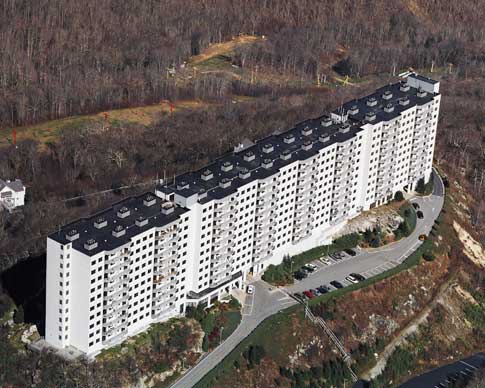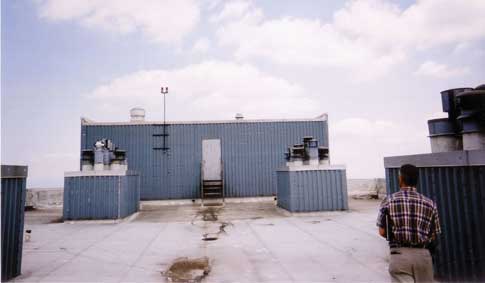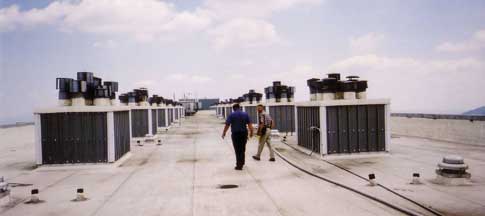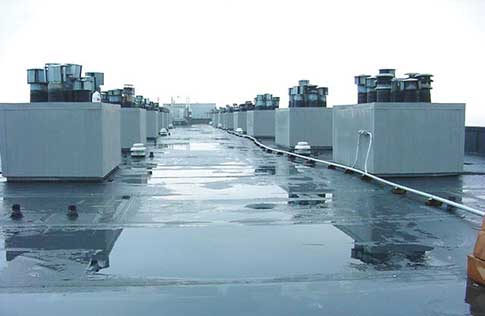SugarTop Condominiums is the highest multistory condominium complex east of the Mississippi River, standing at 5,000 feet (1521 m) on SugarTop Mountain.
But when the building was constructed during the 1980s, its height caused the North Carolina state legislature to pass a "Ridge Law" that stated no buildings higher than two stories could be constructed on any ridges throughout North Carolina. Specifically, the law limits building heights to 40 feet (12 m) and protects ridges at or above a 3,000-foot (912-m) elevation or 500 feet (152 m) or more above an adjacent valley floor.
So when the condominium complex needed a roof system replacement, its complicated and controversial history, as well as its elevation and climatic conditions, provided a challenge for the roofing contracting company that chose to take on the project.
"There are 360 condominiums in a 10-story building on top of a 5,000-foot- (1521-m-) high mountain," says Ken Gwyn, president of Triad Roofing Co. Inc., Winston-Salem, N.C., which was the roofing contracting company selected for the project. "The general contractor and several other entities went bankrupt during construction of this project."
In the face of this somewhat rocky past, Triad Roofing took on the challenge.
Planning ahead
The condominium association hired a roof consulting firm to specify a roof system, and after the bids came in at double the association's budget, it contacted Triad Roofing to specify and install the new roof system.
The design phase for the project began in June 2003, about one year before construction began. Triad Roofing and the project manufacturer, Firestone Building Products Co., Indianapolis, had to examine the existing roof system and research local climatic conditions.
The building's original 44,000-square-foot (4088-m²) roof assembly included lightweight insulating concrete poured over a concrete plank deck. It featured a slip sheet and mechanically attached single-ply thermoplastic roof system. However, after years of being assaulted by inclement weather, the roof system was battered and experiencing leaks.

Project name: SugarTop Condominiums
Project location: Banner Elk, N.C.
Project duration: July 2004-October 2004
Roof system type: EPDM
Roofing contractor: Triad Roofing Co. Inc., Winston-Salem, N.C.
Roofing manufacturer: Firestone Building Products Co., Indianapolis
"When we arrived for our initial inspection of the roof system, there were cinder blocks, logs and other ballast the condominium association had placed on the roof to try to keep the roof from blowing away," says John Dorn, Triad Roofing's vice president in charge of field operations. "There also were caulk blots at about 20,000 locations where holes that appeared to have been caused by hail had been 'repaired' after years of abuse the roof system had taken from the harsh climate."
The actual construction time period carefully had been planned around the area's harsh climate. In 2002, the wind gauge broke when 175-mph (78-m/sec) winds were clocked on Grandfather Mountain, which is 5 miles (8 km) away from SugarTop Condominiums.
"Sometimes, it starts to snow in these areas in September, and we can have snow as late as early May," says Dennis Lacey, manager of SugarTop Condominiums. "And the wind blows here all the time."
As a result, the company began the project in July 2004 and completed it in October 2004.
Installation
The company removed the existing thermoplastic membrane and slip sheet down to the existing lightweight concrete, as well as the existing copings, counterflashings, base flashings and other related materials.

The initial roof system inspection is performed. Photos courtesy of Triad Roofing Co. Inc., Winston-Salem, N.C.
The necessary safety precautions were implemented during the project.
"The existing parapets at the main roof were 48 inches (1219 mm) high, so no other fall protection was required while working on this area," Gwyn says. "Tie-off was maintained and fall protection was implemented while working on the penthouses, where parapets were not present. Daily inspections of power tools and standard safety precautions were observed throughout the project."

The roof had 36 penthouses with 10 fireplace flues each for the wood-burning fireplaces in each condominium unit.
Triad Roofing installed a new roof system from Firestone Building Products.
"The new roof system consisted of 1 1/2-inch- (38-mm-) thick Firestone Hailguard insulation, which was mechanically attached through the existing lightweight insulating concrete and into the structural concrete deck," Gwyn says. "A 90-mil- (0.09-inch- [2-mm-]) thick EPDM membrane was fully adhered to the nailbase insulation."

All exposed fastener metal panels on the penthouses were replaced with concealed fastener panels to ensure no water entry.
Firestone Building Products' Edgeguard perimeter system was installed at the parapets.
Mountain conditions
Location was an issue during the project for a variety of reasons. One reason was the mountain environment made material transportation more difficult.
"Several hairpin turns in the road leading to SugarTop Mountain would not allow tractor-trailers to access the job site," Gwyn says. "A staging area at the bottom of the mountain was used to load materials onto smaller trucks for transport to the construction site. We had to handle the materials twice, which added a couple of days to the overall project."
The mountain weather also caused some issues.
"Unpredictable weather in the North Carolina mountains was the main challenge," Gwyn says. "Our crew would start work at about 4 a.m. to have the new roof system installed and tied in to the old roof before afternoon thunderstorms hit the area. The project also took about 15 days longer than anticipated because of two hurricanes that blasted the North Carolina mountains."
Success
What began with controversy ended with success for Triad Roofing and the SugarTop Condominium complex.
"Triad Roofing did an excellent job," Lacey says. "They completed the project on time and did not charge one cent more than the contract price."
The project also met Gwyn's expectations.
"The owner was happy; the project was completed safely; and it came in under budget," Gwyn says. "There were many challenges during this project, and our team came through with flying colors, as I knew it would."
Krista Reisdorf is managing editor of Professional Roofing magazine.
